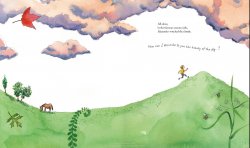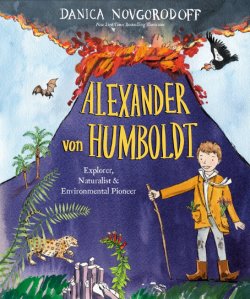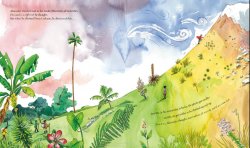
Artwork by Danica Novgorodoff from Alexander Von Humboldt: Explorer, Naturalist, and Environmental Pioneer © 2022 by Crown Books for Young Readers


Reviewed By Peter Shea
There are books about facts, and books about possibilities. Children – and all the other people – need fact-books to know things and to navigate, but they aren’t fun and they don’t inspire minds to go on trips – the sorts of trips to which philosophy sells tickets.
This isn’t everybody’s view, all the time, but it is lots of people’s view, a lot of the time, explaining why Principles of Canadian Geology doesn’t often get stuffed into beach bags – and why the bibliography of thought-provoking children’s books has so little space for science, engineering, and history – yet.
Danica Novgorodoff might shake up such over-stiff categories, if only she just keeps writing. Her introduction to Alexander Von Humboldt, a man who taught people how to see how facts go together, is a masterpiece of practicing what it preaches, and what Humboldt preached. It begins with Humboldt as a boy, seeing birds and mountains and rocks and animals, and coming up with divergent questions. That’s the way a lot of “great scientists” books have to begin, with the junior great man or woman being curious. What this does that’s different is to bring all the nature questions together under two big questions, and then to show how those questions stayed important for Humboldt over a long life – “How are these things different?” and “How are they nevertheless connected?”

Artwork by Danica Novgorodoff from Alexander Von Humboldt: Explorer, Naturalist, and Environmental Pioneer © 2022 by Crown Books for Young Readers
This tight structure of questions opens up this biography to being about thinking and to being a model for thinking. As the reader watches Humboldt looking at a hawk and a mouse, volcanoes and farmland, palm trees and pine trees, Europe and Ecuador, Europeans and Indigenous people, one comes to expect what he will say, “They are different, and yet they are connected.” After a while, perhaps, one begins to inhabit that formula, to expect difference and connection – in many places. An alert teacher can encourage students to try on being Humboldt, being, in one way, ecologists.
The last page of the book shows Humboldt in his prime, returned from his voyages, lecturing. The caption is, “He was no longer alone” – which suggests what every one of Humboldt’s discoveries also points to: if nothing in nature is isolated, disconnected, then I must also understand myself as integral to things, as connected. Scientific curiosity had led him back to the old philosopher’s project: know yourself.
A natural way to proceed forward from this book is just to test out its hypothesis about connection in many directions – that is, to use Humboldt, as Novgorodoff summarizes him, as a model for a way of thinking worth exploring: acknowledging difference, then finding connection. It’s an idea much bigger than “ecology” – at least as one might find that word defined in a biology text. For Humboldt, it was a key to making sense of experience generally, not just a scientific sub-field, and good discussion can try out this general approach.
Here, as everywhere in philosophy, there’s no advantage to proceeding uncritically. Perhaps there are things so different that connection fails. It is no disservice to Humboldt to criticize proposed connections as trivial or uninformative or uninteresting; the discussion about what counts as an important connection can be very rich. Humboldt saw his principle as magical, illuminating the world, and following his lead means looking for a kind of magic in the world, not being satisfied with superficial similarities and relationships.

Artwork by Danica Novgorodoff from Alexander Von Humboldt: Explorer, Naturalist, and Environmental Pioneer © 2022 by Crown Books for Young Readers
A reader might reasonably worry about Novgorodoff’s treatment of one aspect of the legacy of Alexander Von Humboldt: she mentions his radical rejection of slavery in the notes, but not in the body of her story. It is important to make clear to a reader in 2023 that such oppressive practices have been objects of contempt since their inception. They cannot be simply excused as compatible with the morals of their time. There’s room for a companion book on Humboldt’s moral legacy, including his contributions to the independence movements in South America. Perhaps Novgorodoff will revisit this topic someday.
The back matter of the book, usually easy to ignore, is very helpful for this book. It explains the way the author became obsessed with Humboldt’s life, expands the story beyond the focused, structured account in the body of the book, traces the sayings and questions back to sources in Humboldt’s writing, and gives a timeline and a bibliography that would allow someone to easily learn more about this central figure in environmental science. The account of the author’s research, of her efforts to get the details right, helps the reader to see what is special about this, among the many treatments of Humboldt’s life. This structure also makes this book usable at a variety of ages, for a variety of purposes. The bare story could be a bedtime story for a young child. The book as a whole could introduce older children first to Humboldt’s basic insight, and then to the vast number of inquiries arising out of that basic insight. Any reading of this book, at any level, with careful discussion, will start long trains of inquiry.